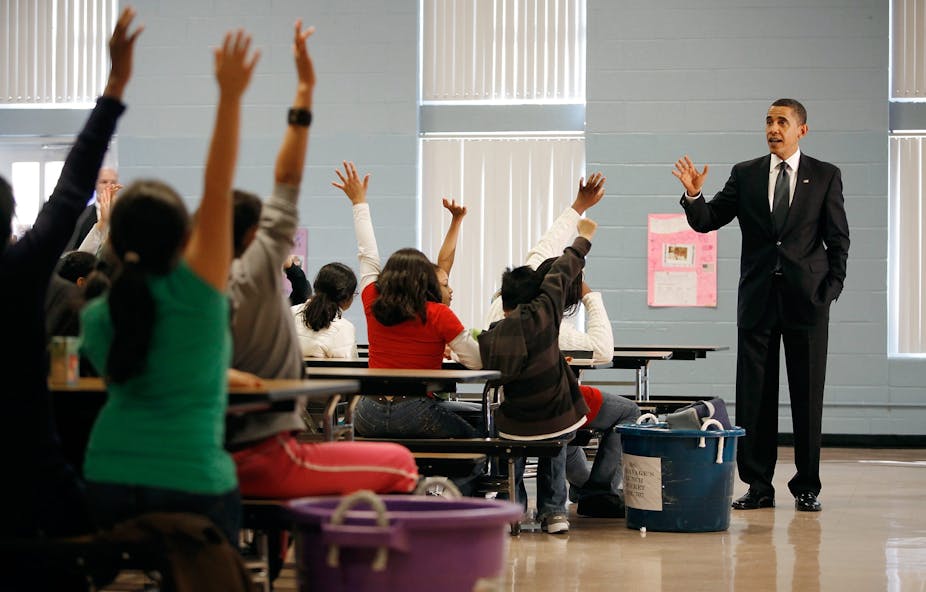Most Americans agree that public education in their country is broken. The infrastructure of thousands of schools is decaying, scores on standardised tests are stagnant, and roughly 1.2 million students who should have graduated from high school in 2011 failed to do so.
One controversial solution which continues to attract the attention of parents, educators, and politicians is government-funded school vouchers. By helping offset tuition at private and religious schools (and facilitating enrolment in a public schools outside a family’s “home district”), voucher programs offer parents of some students – usually low-income children and individuals with special needs – more educational options.
History of school voucher programs
School voucher programs are not new. The oldest continuing programs in the United States, in Vermont and Maine, began in 1869 and 1873. But it is only in the past 20 years that the school choice movement has gained momentum.
The Wisconsin legislature established a voucher program for the city of Milwaukee. Several states followed suit; and privately managed charter schools (authorised by state and municipal governments and eligible for public funds) - with considerable leeway over staffing, programs and curriculum - began to proliferate.
In 2011-2012, 16 school voucher programs served 81,590 students in the United States. Nine states and the District of Columbia and Douglas County, Colorado offer voucher programs of various types.
Advocates claim vouchers give low-income students and others a wider range of educational opportunities, force public schools to improve in order to compete, encourage innovation and accountability, enhance the quality of schools, and give parents more of a stake in – and influence over – the education of their children.
Critics say vouchers neither mandate nor enforce accountability standards for private schools, provide insufficient funds for students to attend the best private schools, and, most important, by removing the most informed, ambitious and competent parents and students, leave public schools with those who are least likely to succeed, and with fewer resources to assist them.
What do the presidential candidates say?
Presidential candidates Barack Obama and Mitt Romney differ about school vouchers as a model for the nation. Although neither the President nor the Democratic Party Platform explicitly oppose vouchers, Obama’s FY13 budget plan eliminated in its entirety the $20 million previously appropriated for the District of Columbia program (unlike other municipalities, D.C. receives a direct subsidy from the federal government for public schools).

Romney enthusiastically embraces vouchers. In his white paper on education, the former Massachusetts governor promises to expand the D.C. Opportunity Scholarship Fund that Obama zeroed out, subsidise parents who want to send their children to a private or religious school, support charter schools, and enable low-income and disabled students to use their federal funding for school choice.
Do vouchers actually work?
At first blush, studies of voucher recipients reveal some impressive results. A Brookings Institution, Harvard University, analysis of New York City students who used vouchers in elementary school in the 1990s found little or no overall impact on college enrolment, except for a significant increase of 24% for African-Americans.
Washington D.C. students who used their voucher graduated from high school at a 91% rate – more than 20% higher than those who expressed interest in the program but did not receive a scholarship and more than 30% higher than the rate in the D.C. public schools. Students in the Milwaukee Parental Choice Program had a 76.6% on-time high school graduation rate – 7.2% higher than the rate in the public schools.
Clearly, vouchers help some students some of the time. But there are substantial costs to the mutually-reinforcing initiatives of vouchers and charter schools. According to Diane Ravitch, Assistant Secretary of Education under President George H.W. Bush and one of the most well-respected (and one of the only non-partisan) experts on education policy in the United States, after 20 years of experiments with vouchers, there is an “emerging consensus” that they are not the answer to the challenges of preparing the next generation of young men and women for the 21st century.
Test scores of African American students in the state of Wisconsin, two-thirds of whom live in Milwaukee, she points out, are among the lowest in the nation. School choice, Ravitch concludes, is making it less likely that the neediest students will be well served and, because resources are tied to enrolments, that the public school system will flourish.
Vouchers are not a panacea. But neither should they be scrapped. They should be part of a comprehensive reform of public education that is truly dedicated to leaving no child behind.

